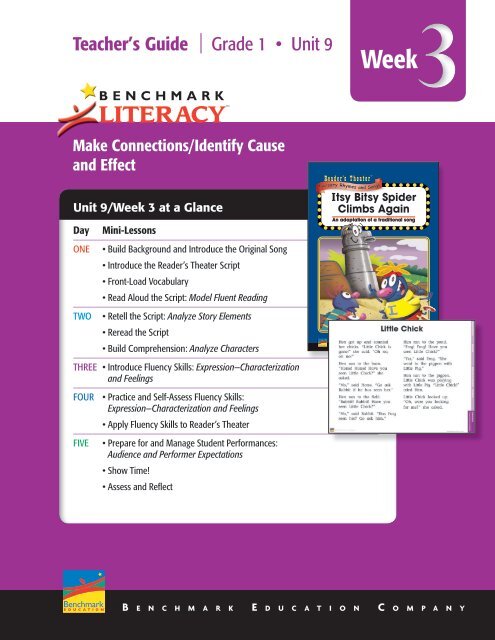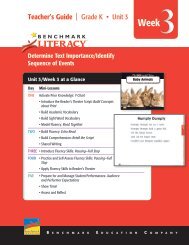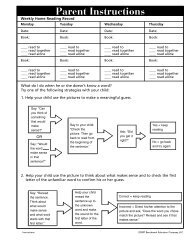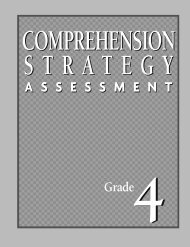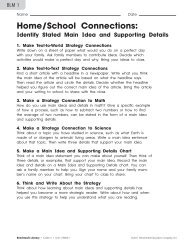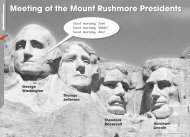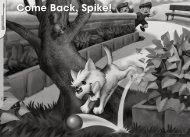Read-Aloud - Benchmark Resources - Benchmark Education ...
Read-Aloud - Benchmark Resources - Benchmark Education ...
Read-Aloud - Benchmark Resources - Benchmark Education ...
You also want an ePaper? Increase the reach of your titles
YUMPU automatically turns print PDFs into web optimized ePapers that Google loves.
Teacher’s Guide Grade 1 • Unit 9<br />
3<br />
Week<br />
<strong>Benchmark</strong><br />
Literacy<br />
TM<br />
Make Connections/Identify Cause<br />
and Effect<br />
Unit 9/Week 3 at a Glance<br />
Day Mini-Lessons<br />
ONE • Build Background and Introduce the Original Song<br />
• Introduce the <strong>Read</strong>er’s Theater Script<br />
• Front-Load Vocabulary<br />
• <strong>Read</strong> <strong>Aloud</strong> the Script: Model Fluent <strong>Read</strong>ing<br />
Nursery Rhymes and Songs<br />
Itsy Bitsy Spider<br />
Climbs Again<br />
An adaptation of a traditional song<br />
TWO<br />
• Retell the Script: Analyze Story Elements<br />
• Reread the Script<br />
• Build Comprehension: Analyze Characters<br />
by Jeffrey B. Fuerst • illustrated by Daryll Collins<br />
THREE • Introduce Fluency Skills: Expression—Characterization<br />
and Feelings<br />
FOUR • Practice and Self-Assess Fluency Skills:<br />
Expression—Characterization and Feelings<br />
• Apply Fluency Skills to <strong>Read</strong>er’s Theater<br />
FIVE<br />
• Prepare for and Manage Student Performances:<br />
Audience and Performer Expectations<br />
• Show Time!<br />
• Assess and Reflect<br />
®<br />
B<br />
e n c h m a r k E d u c a t i o n C o m p a n y
Day One<br />
<strong>Read</strong>-<strong>Aloud</strong> (10 m i n u t e s)<br />
Nursery Rhymes and Songs<br />
Itsy Bitsy Spider<br />
Climbs Again<br />
An adaptation of a traditional song<br />
Select a favorite fiction read-aloud from your classroom or school library<br />
with which to model the metacognitive strategy “Make Connections.” Use the<br />
sample read-aloud lessons and suggested titles provided in the <strong>Benchmark</strong><br />
Literacy Overview.<br />
Mini-Lessons (20 m i n u t e s)<br />
Build Background and Introduce the Original Song<br />
by Jeffrey B. Fuerst • illustrated by Daryll Collins<br />
<strong>Read</strong>er’s Theater Big Book Inside<br />
Front Cover<br />
Lesson Objectives<br />
Students will:<br />
• Review or learn a traditional song.<br />
• Make connections to a song and a<br />
script.<br />
• Identify cause and effect.<br />
• Analyze story elements.<br />
• Analyze character.<br />
• Listen to a fluent reading of the<br />
script.<br />
• Build oral language and vocabulary<br />
through whole-group and partner<br />
discussion.<br />
Related <strong>Resources</strong><br />
• <strong>Read</strong>er’s Theater Whiteboard<br />
CD-ROM<br />
• Sequence of Events Chart (BLM 1)<br />
Ask: Has anyone heard the song “The Itsy Bitsy Spider”? Raise your hand if<br />
you know this song. Allow responses.<br />
Invite individual students who have heard the song to tell you what the song<br />
is about.<br />
Invite volunteers to recite or sing the original song lyrics, if they can.<br />
<strong>Read</strong> <strong>Aloud</strong> the Original Song Lyrics: The Itsy Bitsy Spider<br />
Display the inside front cover of the big book Itsy Bitsy Spider Climbs Again or<br />
display this page of the interactive e-book using the Whiteboard CD-ROM.<br />
<strong>Read</strong> aloud the original song, or play the modeled reading using the interactive<br />
e-book.<br />
Invite students to echo-read the song with you one line at a time. Point to each<br />
word as you read it.<br />
Invite students to choral-read or choral-sing the entire song with you for<br />
repeated oral reading practice.<br />
Discuss what happens and why in “The Itsy Bitsy Spider” and create a simple<br />
Sequence of Events Chart (BLM 1) to show the events. Use the following<br />
question prompts only as needed:<br />
• What did the itsy bitsy spider do?<br />
• What caused the itsy bitsy spider to get washed out?<br />
• Why did the rain dry up?<br />
• What did the itsy bitsy spider do when the sun came out?<br />
Post the Sequence of Events Chart to use as an anchor chart.<br />
2<br />
<strong>Benchmark</strong> Literacy • Grade 1 • Unit 9/Week 3<br />
©2010 <strong>Benchmark</strong> <strong>Education</strong> Company, LLC
Day One<br />
The Itsy Bitsy Spider<br />
The itsy bitsy spider went up the<br />
water spout.<br />
The rain came down. It washed<br />
the spider out of the water spout.<br />
The sun came out. It dried up all<br />
the rain.<br />
The itsy bitsy spider climbed up<br />
the water spout again.<br />
Sample Sequence of Events Chart<br />
Annotations (BLM 1)<br />
Model sentence frames. Support ELLs by modeling how to use the following<br />
sentence frames to discuss the song:<br />
The itsy bitsy spider .<br />
The rain .<br />
The sun .<br />
At the end of the song, .<br />
Introduce the <strong>Read</strong>er’s Theater Script<br />
Display the big book Itsy Bitsy Spider Climbs Again on an easel, or use the<br />
Whiteboard CD-ROM to display the book on your whiteboard.<br />
<strong>Read</strong> aloud the title and the author’s and illustrator’s names on the cover.<br />
Invite students to identify and discuss what they see in the cover illustration.<br />
Make Content Comprehensible<br />
for ELLs<br />
Beginning<br />
Display the inside front cover of the big<br />
book. As you introduce the original song,<br />
point to and name the spider and the<br />
water spout. Then sing the song with<br />
students, using hand gestures to show the<br />
spider climbing up the water spout; the<br />
rain coming down; the sun coming out;<br />
and the spider climbing up again.<br />
Beginning and Intermediate<br />
Have students tell what color the itsy bitsy<br />
spider’s shirt, pants, and sneakers are. Use<br />
the following sentence frame: The itsy bitsy<br />
spider is wearing (a) shirt (pants,<br />
sneakers). Ask: What color is the itsy bitsy<br />
spider’s nose? (pink)<br />
Advanced<br />
Have students describe the characteristics<br />
of real spiders by answering the following<br />
questions:<br />
• How many legs do spiders have?<br />
• What do spiders eat?<br />
• How do they catch the insects they<br />
eat?<br />
Nursery Rhymes and Songs<br />
Itsy Bitsy Spider<br />
Climbs Again<br />
An adaptation of a traditional song<br />
Explain to students that throughout the week they will be reading a new<br />
version of “The Itsy Bitsy Spider” as a group.<br />
Say: Let’s talk about some of the other scripts that we have already<br />
performed. How did the author adapt, or change, the characters and events?<br />
Did you like the changes the author made? Why?<br />
Tell students that at the end of the week they will perform this reader’s theater<br />
adaptation.<br />
by Jeffrey B. Fuerst • illustrated by Daryll Collins<br />
<strong>Read</strong>er’s Theater Big Book<br />
©2010 <strong>Benchmark</strong> <strong>Education</strong> Company, LLC <strong>Benchmark</strong> Literacy • Grade 1 • Unit 9/Week 3 3
Day One<br />
Picture Words<br />
climbed<br />
falling<br />
Activate metacognitive strategies. Use some or all of the following prompts<br />
to help students use strategies to think and make predictions about the script<br />
they will read:<br />
Make connections. Ask: What connections can you already make between<br />
this script and “The Itsy Bitsy Spider” song?<br />
2<br />
Sight Words<br />
am at help here<br />
I look the up<br />
Determine text importance. Ask: What clues does the cover illustration give<br />
you that help you predict what will happen in the script?<br />
Make inferences. Ask: Where can you find clues in the script that will help<br />
you figure out what is happening?<br />
<strong>Read</strong> aloud the title page, including the title, cast of characters, and setting.<br />
Itsy Bitsy Spider Climbs Again, page 2<br />
rain<br />
sun<br />
Invite students to explore the layout, text, and illustrations.<br />
Point out the color coding of the characters’ names and the image icons, and<br />
explain how these help readers know when to read their part.<br />
Discuss the anchor chart of the original and review the concept of an<br />
adaptation. Ask: If you were to write a new version of this song, what parts<br />
would you want to keep? What new things would you add?<br />
Front-Load Vocabulary<br />
Enrichment Words<br />
bitsy<br />
dried<br />
itsy<br />
water<br />
Itsy Bitsy Spider Climbs Again, page 3<br />
3<br />
Turn to the picture, sight, and enrichment words on pages 2–3, or display<br />
these pages using the e-book on the Whiteboard CD-ROM.<br />
Say: We will find many kinds of words in this script. The words you see here<br />
are all in the script. Let’s read these words together before we start reading.<br />
Point to each picture word and read it with students. Then ask students to use<br />
each picture word in a sentence.<br />
Invite volunteers to read any sight words they already know. Invite other<br />
students to repeat each word and suggest a meaningful sentence using<br />
the word.<br />
Point to each enrichment word as you say it. Use the following prompts to<br />
encourage students to incorporate these words into their oral vocabulary:<br />
• What other animals can you name that are itsy bitsy, or tiny?<br />
• What are two ways that clothes can be dried?<br />
• What happens when water freezes?<br />
4<br />
<strong>Benchmark</strong> Literacy • Grade 1 • Unit 9/Week 3<br />
©2010 <strong>Benchmark</strong> <strong>Education</strong> Company, LLC
Day One<br />
<strong>Read</strong> <strong>Aloud</strong> the Script: Model Fluent <strong>Read</strong>ing<br />
Have students listen and follow along as you read the whole script aloud to<br />
model fluency and expression. Be sure to make your voice show excitement<br />
for exclamations and fall at the end of statements. (As an alternative, play the<br />
talking e-book on the Whiteboard CD-ROM, and instruct students to listen and<br />
follow along as the text is read and highlighted.)<br />
Connect and transfer. Say: Today we made connections between the song<br />
“The Itsy Bitsy Spider” and the script. Tomorrow, we will use this strategy as<br />
we figure out what happens in the script and why it happens. Remember that<br />
good readers are always using what they know to make new connections and<br />
figure out why things happen.<br />
Small-Group <strong>Read</strong>ing Instruction (60 m i n u t e s)<br />
Based on students’ instructional reading levels and comprehension needs,<br />
select titles that provide opportunities for students to continue to practice<br />
identifying cause and effect (see the list provided on the Small-Group <strong>Read</strong>ing<br />
Instructional Planner), or select titles that enable students to review previously<br />
taught comprehension strategies.<br />
Use the instruction provided in the Teacher’s Guide to introduce the texts.<br />
Individual Student Conferences (10 m i n u t e s)<br />
Confer with individual students on their text selections and application of<br />
strategies. Use the <strong>Read</strong>ing Conference Note-Taking Form to help guide your<br />
conference.<br />
Support Special Needs Learners<br />
Throughout the week, use the following<br />
strategies to help students who have<br />
learning disabilities access the content<br />
and focus on skills and strategies.<br />
Support visual learners and students<br />
with attention issues by projecting the<br />
whiteboard version of the big book.<br />
Have students highlight key words on the<br />
whiteboard as they say them.<br />
Support auditory learners by playing the<br />
e-book readings of the song and script.<br />
During independent workstation time, pair<br />
special needs students with more fluent<br />
readers for partner-reading practice of the<br />
script.<br />
Group students heterogeneously for<br />
small-group reading of the script so that<br />
struggling students benefit from working<br />
with more fluent readers.<br />
Assign multiple students to specific roles so<br />
that they can support one another.<br />
Fluency Quick-Check<br />
Throughout the week, refer to the Fluency<br />
Rubric provided in the <strong>Benchmark</strong><br />
Literacy Ongoing Assessments to help you<br />
informally assess where students are in<br />
their development of key areas of fluency.<br />
Name<br />
Date<br />
Phonics Workshop (20 m i n u t e s)<br />
Use the Day 1 instruction provided in BuildUp Phonics Skill Bag 27.<br />
The key elements of reading fluency—accuracy, speed, pacing, pausing, inflection/intonation,<br />
expression, phrasing, and the integration of these skills—may be assessed any time a student<br />
reads aloud. Discuss the assessment rubric, modeling each description, so students know<br />
what you expect.<br />
Fluency Rubric<br />
Rating Elements of Fluent <strong>Read</strong>ing<br />
Scale<br />
Accuracy<br />
1 Multiple attempts at decoding words are unsuccessful. Word reading accuracy is<br />
inadequate/poor, below 90%.<br />
2 Attempts to self-correct errors are usually unsuccessful. Word reading accuracy is marginal,<br />
between 90–93%.<br />
3 Attempts to self-correct errors are successful. Word reading accuracy is good, between 94–97%.<br />
4 Most words are read correctly on initial attempt. Minimal self-corrections, all successful.<br />
Word reading accuracy is excellent, 98–100%.<br />
Rate: Speed, Pacing, Pausing<br />
1 <strong>Read</strong>ing is slow and laborious.<br />
2 <strong>Read</strong>ing is either moderately slow or inappropriately fast, and pausing is infrequent or ignored.<br />
3 <strong>Read</strong>ing is an unbalanced combination of slow and fast reading containing inconsistent<br />
pausing.<br />
4 <strong>Read</strong>ing is consistently natural, conversational, and appropriately varied (resembling natural<br />
oral language).<br />
Prosody: Inflection/Intonation and Expression<br />
1 <strong>Read</strong>s in an inexpressive, monotone manner and does not attend to punctuation.<br />
2 <strong>Read</strong>s with some intonation (pitch/tone/volume/stress) and some attention to punctuation.<br />
<strong>Read</strong>s in a monotone at times.<br />
3 <strong>Read</strong>s by adjusting intonation (pitch/tone/volume/stress) inappropriately. Consistently attends<br />
to punctuation.<br />
4 <strong>Read</strong>s with intonation that reflects feeling, anticipation, tension, character development,<br />
and mood.<br />
Prosody: Phrasing<br />
1 <strong>Read</strong>s word by word. Does not attend to author’s syntax or sentence structures. Has limited<br />
sense of phrase boundaries.<br />
2 <strong>Read</strong>s slowly and in a choppy manner, usually in two-word phrases. Some attention is<br />
given to author’s syntax and sentence structures.<br />
3 <strong>Read</strong>s in phrases of three to four words. Appropriate syntax is used.<br />
4 <strong>Read</strong>s in longer, more meaningful phrases. Regularly uses phrase boundaries, punctuation,<br />
sentence structure, and author’s syntax to reflect comprehension and fluent reading.<br />
Integration<br />
1 <strong>Read</strong>ing is monotone, laborious, inexpressive, and accuracy rate is poor, below 90%.<br />
2 <strong>Read</strong>ing is unbalanced with inconsistent rate and pacing, some phrasing, inadequate<br />
intonation and expression, marginal accuracy, between 90–93%.<br />
3 <strong>Read</strong>ing is somewhat adjusted with some variation in rate, appropriate prosody, and with<br />
good accuracy, between 94–97%.<br />
4 <strong>Read</strong>s in an integrated manner with high accuracy, rate, intonation, and expression on a<br />
consistent basis. Fluent reading reflects understanding and interpretation of text.<br />
Fluency Rubric<br />
©2010 <strong>Benchmark</strong> <strong>Education</strong> Company, LLC <strong>Benchmark</strong> Literacy • Grade 1 • Unit 9/Week 3 5
Day Two<br />
<strong>Read</strong>-<strong>Aloud</strong> (10 m i n u t e s)<br />
Nursery Rhymes and Songs<br />
Itsy Bitsy Spider<br />
Climbs Again<br />
An adaptation of a traditional song<br />
Select a favorite fiction read-aloud from your classroom or school library<br />
with which to model the metacognitive strategy “Make Connections.” Use the<br />
sample read-aloud lessons and suggested titles provided in the <strong>Benchmark</strong><br />
Literacy Overview.<br />
Mini-Lessons (20 m i n u t e s)<br />
Retell the Script: Analyze Story Elements<br />
by Jeffrey B. Fuerst • illustrated by Daryll Collins<br />
<strong>Read</strong>er’s Theater Big Book<br />
Lesson Objectives<br />
Students will:<br />
• Retell story elements.<br />
• Reread to build fluency.<br />
• Analyze characters.<br />
• Build oral language and vocabulary<br />
through whole-group and partner<br />
discussion.<br />
Related <strong>Resources</strong><br />
• <strong>Read</strong>er’s Theater Whiteboard<br />
CD-ROM<br />
• Sequence of Events Chart (BLM 1)<br />
• The Itsy Bitsy Spider (BLM 2)<br />
Say: Yesterday we read Itsy Bitsy Spider Climbs Again. Let’s take a few<br />
minutes to retell what we know about the characters and what they do in this<br />
script. Raise your hand if you would like to share something that happened in<br />
the script, and I will call on you.<br />
Lead a discussion about the story characters and events. Allow students to<br />
recall as much information as they can without prompting. If necessary, use<br />
the following questions to guide students’ retelling:<br />
• What does Itsy do at the beginning of the script?<br />
• Who watches Itsy go up the water spout?<br />
• What happens after it begins to rain?<br />
• How do Itsy’s friends feel?<br />
• What happens when the sun comes out?<br />
Support ELLs in retelling information by providing the following sentence<br />
frames to help them produce academic language:<br />
Itsy goes .<br />
Itsy falls down because .<br />
The hot sun .<br />
Shared Writing. Record students’ retelling on the Sequence of Events Chart<br />
(BLM 1) that you started on Day 1.<br />
The Itsy Bitsy Spider<br />
The itsy bitsy spider went up the water<br />
spout.<br />
Itsy Bitsy Spider Climbs Again<br />
Itsy went up the water spout. His friends<br />
watched him.<br />
The rain came down. It washed the<br />
spider out of the water spout.<br />
The sun came out. It dried up all the rain.<br />
The itsy bitsy spider climbed up the<br />
water spout again.<br />
The rain washed Itsy out. Itsy’s friends<br />
felt bad.<br />
The sun came out. It dried up all the rain.<br />
Itsy climbed up the water spout again.<br />
His friends cheered.<br />
Sample Sequence of Events Chart Annotations (BLM 1)<br />
6<br />
<strong>Benchmark</strong> Literacy • Grade 1 • Unit 9/Week 3<br />
©2010 <strong>Benchmark</strong> <strong>Education</strong> Company, LLC
Day Two<br />
Reread the Script<br />
Conduct a shared reading of the entire book, inviting students to chime in<br />
when they know the words. You might want to assign specific students to help<br />
you read certain parts of the script. For example, some students could read the<br />
parts of Spider 1 and Spider 2. Others could read the part of the Water Spout.<br />
Next, choral-read the script as a group. Encourage students to read with as<br />
much expression as they can.<br />
Build Comprehension: Analyze Characters<br />
Turn to the cast of characters on the title page.<br />
Say: When you perform a reader’s theater script, you need to understand<br />
your character. Then you will be able to play that character in a convincing<br />
way. For example, you might ask yourself, “How would a brave character look<br />
and act? How would a caring character act?”<br />
Think/Pair/Share. Ask pairs of students to discuss one character from the<br />
script (Itsy Spider, Spider 1, or Spider 2) and to write one or two sentences<br />
that describe the character. Have pairs share their descriptive sentences with<br />
the class as you record them on a two-column chart about the characters.<br />
Have volunteers read aloud the sentences in each column. Discuss how each<br />
character might speak and act based on students’ descriptions.<br />
Connect and transfer. Say: Tomorrow during small-group reading, each of<br />
you will be assigned a role in this script. We will practice reading the script.<br />
At the end of the week, you will get to perform the script. Remember to use<br />
all the strategies we’ve practiced to help you understand your part. You can<br />
make connections to figure out why the characters act the way they do.<br />
Make Content Comprehensible<br />
for ELLs<br />
Beginning<br />
Invite ELLs and other students to role-play<br />
their characters’ personalities. Point out<br />
that Itsy kept trying to climb the water<br />
spout and his friends cheered him on.<br />
Beginning and Intermediate<br />
Reread the picture, sight, and enrichment<br />
words on pages 2–3 of the big book.<br />
Provide opportunities for ELLs to use the<br />
words in oral sentences. For example, say:<br />
Itsy climbed a water spout. What things<br />
have you climbed? Do you like rain?<br />
Advanced<br />
Have students role-play other challenging<br />
things Itsy might do in the future. Have them<br />
also role-play what his friends would say.<br />
Comprehension Quick-Check<br />
Note students who have difficulty<br />
analyzing the story characters. Support<br />
them with the following explicit instruction.<br />
Create sentence frames for each character<br />
for students to complete, such as:<br />
Itsy is a spider.<br />
Spider 1 and Spider 2 are .<br />
Point to specific illustrations and text in<br />
the big book to support students’ sentence<br />
frames.<br />
Reinforce the fact that good readers pay<br />
careful attention to characters’ actions,<br />
words, feelings, and expressions.<br />
Say: Remember, in order to read with the<br />
correct expression you need to understand<br />
your character.<br />
©2010 <strong>Benchmark</strong> <strong>Education</strong> Company, LLC <strong>Benchmark</strong> Literacy • Grade 1 • Unit 9/Week 3 7
Day Two<br />
Home/School Connection<br />
Have students take home The Itsy Bitsy<br />
Spider (BLM 2) and read it with a family<br />
member. Have students draw a picture to<br />
illustrate the song.<br />
BLM 2<br />
Name<br />
Date<br />
The Itsy Bitsy Spider<br />
Parent Instructions: <strong>Read</strong> the song to your child. Point to each<br />
word as you read. Then read the words together. Finally, invite your<br />
child to draw a picture about the song.<br />
Small-Group <strong>Read</strong>ing Instruction (60 m i n u t e s)<br />
Based on students’ instructional reading levels and comprehension needs,<br />
select titles that provide opportunities for students to continue to practice<br />
identifying cause and effect (see the list provided on the Small-Group <strong>Read</strong>ing<br />
Instructional Planner), or select titles that enable students to review previously<br />
taught comprehension strategies.<br />
Use the instruction provided in the Teacher’s Guide to introduce the texts.<br />
The itsy bitsy spider<br />
went up the water spout.<br />
Down came the rain,<br />
and washed the spider out.<br />
Out came the sun,<br />
and dried up all the rain.<br />
And the itsy bitsy spider<br />
climbed up the spout again.<br />
Individual Student Conferences (10 m i n u t e s)<br />
Confer with individual students on their text selections and application of<br />
strategies. Use the <strong>Read</strong>ing Conference Note-Taking Form to help guide your<br />
conference.<br />
<strong>Benchmark</strong> Literacy • Grade 1 • Unit 9/Week 3<br />
©2010 <strong>Benchmark</strong> <strong>Education</strong> Company, LLC<br />
Phonics Workshop (20 m i n u t e s)<br />
The Itsy Bitsy Spider (BLM 2)<br />
Use the Day 2 instruction provided in BuildUp Phonics Skill Bag 27.<br />
Oral Language Extension<br />
Display the big book during independent<br />
workstation time. Have pairs of students<br />
retell and make connections to the script<br />
using the prompts and pictures on the<br />
inside back cover. Students should be<br />
prepared to discuss their ideas as well as<br />
their favorite character during independent<br />
conferencing time.<br />
8<br />
<strong>Benchmark</strong> Literacy • Grade 1 • Unit 9/Week 3<br />
©2010 <strong>Benchmark</strong> <strong>Education</strong> Company, LLC
Day Three<br />
<strong>Read</strong>-<strong>Aloud</strong> (10 m i n u t e s)<br />
Select a favorite nonfiction read-aloud from your classroom or school library<br />
with which to model the metacognitive strategy “Make Connections.” Use the<br />
sample read-aloud lessons and suggested titles provided in the <strong>Benchmark</strong><br />
Literacy Overview.<br />
Mini-Lessons (20 m i n u t e s)<br />
Introduce Fluency Skills: Expression—Characterization<br />
and Feelings<br />
Explain: We have learned that we use expression when we read. We use<br />
clues—such as the title, pictures, bold print, or punctuation—to figure out the<br />
mood of a passage. Some passages have quotation marks. When we see<br />
quotation marks, we need to think about what that story character is saying.<br />
The words, along with how the character acts, give us clues about what the<br />
character is like and how he or she feels. We then try to make our voices<br />
sound the way that character might talk.<br />
Display the fluency poster “Little Chick” and read aloud the title. (Note: The<br />
poster is also available as BLM 3.)<br />
Say: This is a story about a missing chick. The hen is very worried, so I will<br />
use a worried voice to read her parts. The farm animals try to help, so I will<br />
use a helpful voice for their parts. Little Chick is very surprised that everyone<br />
is looking for her, so I will use a surprised voice for her part. <strong>Read</strong>ing the<br />
characters’ words in these different ways will help the story sound right and<br />
make sense.<br />
Fluency Poster<br />
Lesson Objectives<br />
Students will:<br />
• Practice reading a story with<br />
effective expression.<br />
• Compose a class Fluency anchor<br />
chart.<br />
• Build oral language and vocabulary<br />
through whole-group and partner<br />
discussion.<br />
Related <strong>Resources</strong><br />
• Little Chick (BLM 3)<br />
Ask students to listen and follow along as you read the story aloud<br />
as described.<br />
Say: Now I will read the characters’ parts showing different feelings. I will<br />
pretend that everyone is angry.<br />
<strong>Read</strong> the first three paragraphs in an angry manner. Then repeat using other<br />
feelings, such as pride, delight, or confusion.<br />
Ask: Which way sounds the best? Why?<br />
©2010 <strong>Benchmark</strong> <strong>Education</strong> Company, LLC <strong>Benchmark</strong> Literacy • Grade 1 • Unit 9/Week 3 9
Day Three<br />
Make Content Comprehensible<br />
for ELLs<br />
Beginning and Intermediate<br />
Orally demonstrate how to read in a happy<br />
tone, a worried tone, and a surprised tone.<br />
Invite students to echo-read in the various<br />
tones.<br />
Invite ELLs to talk about animals that live<br />
on a farm, using this sentence frame:<br />
A lives on a farm. Write students’<br />
sentences on chart paper and read them<br />
aloud together.<br />
All Levels<br />
Before reading the poster to model<br />
fluency, reinforce the identity of each<br />
animal character by showing pictures of<br />
a chick, a hen, a horse, a rabbit, a frog, and<br />
a pig.<br />
Comprehension Quick-Check<br />
The goal of fluency practice is to<br />
increase comprehension. Use the<br />
following questions to check students’<br />
comprehension of the story:<br />
• Why was Hen worried?<br />
• Where do you think this story takes<br />
place?<br />
• Why do you think Little Chick was so<br />
surprised?<br />
Home/School Connection<br />
Invite students to take home Little Chick<br />
(BLM 3) and choral-read it with a family<br />
member to build fluency.<br />
Shared Writing. Invite students to help you create a class anchor chart to<br />
remind them how good readers read with expression, or reread the anchor<br />
chart from Unit 8. (See the example below.) When you are finished, ask<br />
students to echo-read the entire chart. Then post the chart in the classroom for<br />
future reference.<br />
Connect and transfer. Say: Today during small-group reading, pay attention<br />
to the tone of your voice as you read. Make sure your tone of voice matches<br />
the way the character feels.<br />
Expression<br />
• We do not use the same tone of voice<br />
for everything we read.<br />
• Our tone of voice should match the<br />
mood of the passage.<br />
• We can figure out, or anticipate, the<br />
mood from the title and other clues.<br />
• We can use the author’s or characters’<br />
words to confirm their feelings.<br />
• <strong>Read</strong>ing with expression helps the<br />
passage sound right and make sense.<br />
• We use pacing, pausing, inflection/<br />
intonation, and phrasing to read with<br />
expression.<br />
Sample Anchor Chart<br />
Small-Group <strong>Read</strong>ing Instruction (60 m i n u t e s)<br />
Use the small-group reading time to read Itsy Bitsy Spider Climbs Again.<br />
Use the Day 3 instruction provided in the Nursery Rhymes and Songs<br />
Teacher’s Guide to assign roles and guide students’ reading of the script.<br />
Individual Student Conferences (10 m i n u t e s)<br />
Confer with individual students to discuss their script roles and how they plan<br />
to read their parts. Use the <strong>Read</strong>ing Conference Note-Taking Form to help<br />
guide your conference.<br />
Phonics Workshop (20 m i n u t e s)<br />
Use the Day 3 instruction provided in BuildUp Phonics Skill Bag 27.<br />
10<br />
<strong>Benchmark</strong> Literacy • Grade 1 • Unit 9/Week 3<br />
©2010 <strong>Benchmark</strong> <strong>Education</strong> Company, LLC
Day Four<br />
<strong>Read</strong>-<strong>Aloud</strong> (10 m i n u t e s)<br />
Select a favorite nonfiction read-aloud from your classroom or school library<br />
with which to model the metacognitive strategy “Make Connections.” Use the<br />
sample read-aloud lessons and suggested titles provided in the <strong>Benchmark</strong><br />
Literacy Overview.<br />
Mini-Lessons (20 m i n u t e s)<br />
Practice and Self-Assess Fluency Skills:<br />
Expression—Characterization and Feelings<br />
Distribute copies of Little Chick (BLM 3).<br />
Ask students to echo-read each sentence, and then have them choral-read the<br />
story with you.<br />
Next, allow the group to choral-read the story without your assistance.<br />
Distribute the Fluency Self-Assessment Master Checklist (BLM 4) and review<br />
the assessment criteria for expression and integration (see the checklist on<br />
page 12). Ask students to give a thumbs-up or thumbs-down on each question<br />
based on the group’s choral-reading. Discuss their responses.<br />
Partner reading. Pair students, and ask them to read “Little Chick” together<br />
one or more times.<br />
Monitor students’ partner-reading practice and provide responsive feedback<br />
using the appropriate prompts from the list on page 12.<br />
Fluency Poster<br />
Lesson Objectives<br />
Students will:<br />
• Use the characters’ words and<br />
actions to determine what they are<br />
like and how they feel.<br />
• Demonstrate understanding of the<br />
text through purposeful expression.<br />
• Use effective expression to make<br />
their reading sound like talking.<br />
Related <strong>Resources</strong><br />
• Little Chick (BLM 3)<br />
• Fluency Self-Assessment Master<br />
Checklist (BLM 4)<br />
Ask students to rate themselves on specific fluency skills covered in this lesson<br />
using their Fluency Self-Assessment Master Checklist (BLM 4).<br />
Connect and transfer. Ask students to reflect on their fluency practice, using<br />
the following prompts:<br />
• Why is it important to match your tone of voice to the way the<br />
character feels and acts?<br />
• How can punctuation help you read with expression?<br />
• How will you use what you have learned as you practice reading<br />
Itsy Bitsy Spider Climbs Again?<br />
©2010 <strong>Benchmark</strong> <strong>Education</strong> Company, LLC <strong>Benchmark</strong> Literacy • Grade 1 • Unit 9/Week 3 11
Day Four<br />
Make Content Comprehensible<br />
for ELLs<br />
Beginning<br />
Allow ELLs to participate through active<br />
listening while other students demonstrate<br />
effective expression. Invite them to indicate<br />
when students sound as if they are talking<br />
the same way the characters would.<br />
Intermediate and Advanced<br />
Allow ELLs to read parts of the script<br />
chorally with you or other students as they<br />
demonstrate effective expression.<br />
Responsive Prompts for Expression<br />
Goal Oriented<br />
• Let’s read the title and look at the pictures. That will help us anticipate the<br />
mood of the passage.<br />
• I see quotation marks, so the character is talking. I need to make my voice<br />
sound like the character’s voice.<br />
• I’ll pretend to be that character. Listen to how I make my reading sound<br />
like he or she might talk.<br />
• I need to make my voice, face, and body match what the character is<br />
saying when I read.<br />
• Listen to me read this. Can you hear how worried (helpful, surprised,<br />
excited, frightened, sad) my voice sounds?<br />
BLM 4<br />
Name<br />
<strong>Benchmark</strong> Literacy • Grade 1 • Unit 9/Week 3<br />
Date<br />
Fluency Self-Assessment Master Checklist<br />
Speed/Pacing<br />
Did my speed and pacing match the kind of text I was reading?<br />
Did my speed and pacing match what the character was saying?<br />
Did I read with a natural talking voice?<br />
Did I slow my reading down when appropriate?<br />
Did I pay attention to punctuation?<br />
Pausing<br />
Did I pause to keep from running all my words together?<br />
Did I pause in the correct locations?<br />
Did I pause for the appropriate length of time?<br />
Did I pause to help my reading make sense?<br />
Did I use punctuation to help me figure out when to pause?<br />
Inflection/Intonation<br />
Did I make my voice rise at a question mark?<br />
Did I make my voice fall at a period?<br />
Did I think about what the author was saying so I would know when<br />
to read louder or softer?<br />
Did I think about what the author was saying so I would know when<br />
to stress or emphasize words?<br />
Phrasing<br />
Did I notice the phrases?<br />
Did I read all the words in each phrase together?<br />
Did I think about what the words in the phrase mean when they are<br />
together?<br />
Expression<br />
Did I look for clues so I could anticipate the mood of the passage?<br />
Did I use my tone of voice, facial expressions, and body language to<br />
express what the author or characters were thinking or feeling?<br />
Did I change my reading when something new was about to happen?<br />
Integration<br />
Did I read the words right? (accuracy)<br />
Did I read the words at the right speed? (rate)<br />
Did I read with expression? (prosody)<br />
Did my reading sound like talking?<br />
Did I understand what I read?<br />
Fluency Self-Assessment Master<br />
Checklist (BLM 4)<br />
s<br />
S<br />
©2010 <strong>Benchmark</strong> <strong>Education</strong> Company, LLC<br />
Directive and Corrective Feedback<br />
• What kind of passage do you think this will be? How should you read it?<br />
• Make your voice sound worried (helpful, surprised, excited, frightened,<br />
sad).<br />
• Make your tone of voice match the character’s words.<br />
• Make the character’s voice match his or her actions and feelings.<br />
• <strong>Read</strong> it like the author would say it.<br />
• Repeat after me and read with expression.<br />
• Use the punctuation to help you put expression in your voice when you read.<br />
Self-Monitoring and Reflection<br />
• How did you know what tone of voice to use?<br />
• Did you read with expression?<br />
• Where did you read with good expression?<br />
• What part do you need to read again with more expression?<br />
• Did you have any trouble reading with expression?<br />
• Did you use pacing (pausing, inflection/intonation, phrasing) to help you<br />
read with expression?<br />
Validating and Confirming<br />
• You noticed the funny pictures, so you used a happy tone of voice. Good<br />
thinking.<br />
• You sounded worried (helpful, surprised, excited, frightened, sad) when<br />
you read that.<br />
• I like the way you read it like the character was talking.<br />
• I like the way you read with expression.<br />
• I noticed that you read it just like talking.<br />
• You paid careful attention to pacing (pausing, inflection/intonation,<br />
phrasing) to help you read with expression. Good work!<br />
12<br />
<strong>Benchmark</strong> Literacy • Grade 1 • Unit 9/Week 3<br />
©2010 <strong>Benchmark</strong> <strong>Education</strong> Company, LLC
6<br />
8<br />
7<br />
9<br />
Day Four<br />
Apply Fluency Skills to <strong>Read</strong>er’s Theater<br />
Display the Itsy Bitsy Spider Climbs Again big book and turn to page 6.<br />
Say: Let’s take what we have learned about expression and use it as we<br />
reread a few pages of the script. Listen as I read. After I finish, I want you to<br />
tell me whether I sounded as if I were talking just like the character would.<br />
Narrator: Then . . . boom!<br />
A thundercloud burst open.<br />
Down came a heavy<br />
rainstorm.<br />
Spider 1: Look.<br />
Spider 2: Look at the rain.<br />
Spout: Oh no!<br />
Itsy: Help!<br />
<strong>Read</strong> pages 6–9. Vary your tone and read with expression. Follow the<br />
suggestions below or interpret the text in your own way:<br />
• Itsy: speaks with a frightened voice on pages 7 and 9<br />
• Spider 1 and Spider 2: speak with worried voices on page 6 and sad<br />
voices on page 8<br />
• Narrator: speaks in an excited voice on page 6 and a sad voice on<br />
page 8<br />
• Spout: speaks in an excited voice on page 7 and a sad voice on page 9<br />
Ask students to comment on your reading and how it affected them as<br />
listeners. Then invite volunteers to read aloud with expression so that they<br />
sound just like the characters would.<br />
Itsy Bitsy Spider Climbs Again, pages 6–7<br />
Itsy: Help! I am falling.<br />
Spout: Bye, Itsy.<br />
Narrator: The rain washed<br />
the spider out.<br />
Spider 1: Look.<br />
Spider 2: Look at Itsy.<br />
Itsy Bitsy Spider Climbs Again, pages 8–9<br />
Small-Group <strong>Read</strong>ing Instruction (60 m i n u t e s)<br />
Practice reading Itsy Bitsy Spider Climbs Again. Use the Day 4 instruction<br />
provided in the Nursery Rhymes and Songs Teacher’s Guide to help students<br />
rehearse for their performance.<br />
Individual Student Conferences (10 m i n u t e s)<br />
Confer with individual students on their fluency development. Use the <strong>Read</strong>ing<br />
Conference Note-Taking Form to help guide your conference.<br />
Phonics Workshop (20 m i n u t e s)<br />
Use the Day 4 instruction provided in BuildUp Phonics Skill Bag 27.<br />
Oral Language Extension<br />
Have pairs of students practice fluency<br />
during independent workstation time by<br />
reading “Little Chick” in the following ways:<br />
• choral-read the story together<br />
• partner-read, having one student read<br />
the part of Hen and the other student<br />
read the parts of the other animals<br />
• partner-read again, this time switching<br />
roles<br />
Remind students to support each other’s<br />
fluency development by providing support<br />
as needed and by giving positive feedback.<br />
Home/School Connection<br />
Have students take home Little Chick<br />
(BLM 3) and read it with a family member<br />
to practice fluent reading. Tell students to<br />
have their family member sign their paper.<br />
©2010 <strong>Benchmark</strong> <strong>Education</strong> Company, LLC <strong>Benchmark</strong> Literacy • Grade 1 • Unit 9/Week 3 13
Day Five<br />
<strong>Read</strong>-<strong>Aloud</strong> (10 m i n u t e s)<br />
Nursery Rhymes and Songs<br />
Itsy Bitsy Spider<br />
Climbs Again<br />
An adaptation of a traditional song<br />
Revisit the week’s read-alouds to make text-to-text connections and provide<br />
opportunities for reader response. Use the suggested activities in the<br />
<strong>Benchmark</strong> Literacy Overview, or implement ideas of your own.<br />
Mini-Lessons (20 m i n u t e s)<br />
Prepare for and Manage Student Performances:<br />
Audience and Performer Expectations<br />
by Jeffrey B. Fuerst • illustrated by Daryll Collins<br />
<strong>Read</strong>er’s Theater Big Book<br />
Lesson Objectives<br />
Students will:<br />
• Demonstrate their level of fluency<br />
development through an oral<br />
reading interpretation of the script.<br />
• Demonstrate active listening skills.<br />
• Reflect on and assess their own<br />
fluency development.<br />
Related <strong>Resources</strong><br />
• <strong>Read</strong>er’s Theater Whiteboard<br />
CD-ROM<br />
• <strong>Read</strong>er’s Theater Self-Assessment<br />
(BLM 5)<br />
Prepare students for their reader’s theater performances by sharing your<br />
expectations of audience members and performers.<br />
Audience expectations. Say: While you are listening to the other groups<br />
perform, I expect you to do the following:<br />
• Give your classmates your full attention.<br />
• Do not speak to your neighbors or make any noise.<br />
• Enjoy their performance and show your appreciation by clapping when<br />
they are finished.<br />
• Be prepared to give your feedback on the script, and always remember<br />
to make your feedback constructive, or helpful.<br />
Performer expectations. Say: While you and your group are performing the<br />
script, remember to do these things:<br />
• <strong>Read</strong> in a loud, clear voice and act out your role.<br />
• Use expression and fluency to help everyone listening to understand<br />
your character.<br />
• Remember to vary your voice and expression to match how the<br />
character feels and acts.<br />
• When it is not your turn to read, follow along in the script so you know<br />
when to come in.<br />
• If one of your group members gets lost or forgets to come in, prompt<br />
him or her quietly.<br />
• Accept both suggestions and praise from your audience.<br />
Show Time!<br />
Invite students to perform the script for an audience, such as members of the<br />
class, students from other classes, school staff members, or parents.<br />
Continue your performances during small-group reading time, giving each<br />
group the opportunity to perform.<br />
14<br />
<strong>Benchmark</strong> Literacy • Grade 1 • Unit 9/Week 3<br />
©2010 <strong>Benchmark</strong> <strong>Education</strong> Company, LLC
Day Five<br />
Assess and Reflect<br />
After all groups have completed their performance, use the following selfassessment<br />
activity (also available in the Nursery Rhymes and Songs Teacher’s<br />
Guide) to help students reflect on their performance, identify how they have<br />
improved as readers and performers, and determine what they will focus on<br />
as they participate in future reader’s theater experiences throughout the year.<br />
Draw a three-column reflection chart on chart paper. Include a column for<br />
Reflection Questions and columns to answer Yes or No in response. Use the<br />
following questions to guide the group’s assessment of their performance, or<br />
use the <strong>Read</strong>er’s Theater Self-Assessment (BLM 5). Place a check mark in the<br />
appropriate column, noting their responses.<br />
• Did we make our reading sound smooth like talking?<br />
• Did we make our characters sound and feel like real people<br />
(or animals/objects) with feelings?<br />
• Did we act out our parts with our voices and body language?<br />
• Were our parts at “just right” reading levels?<br />
• Did we practice our reading many times before performing?<br />
• Did we use expression to make our reading sound like talking?<br />
Connect and transfer. Discuss ways to improve future performances based<br />
on the self-assessment and reflections.<br />
BLM 5<br />
Name<br />
<strong>Benchmark</strong> Literacy • Grade 1 • Unit 9/Week 3<br />
<strong>Read</strong>er’s Theater Self-Assessment (BLM 5)<br />
Home/School Connection<br />
You may wish to print copies of the<br />
script from the Whiteboard CD-ROM and<br />
encourage students to perform the script<br />
at home with family members.<br />
Date<br />
<strong>Read</strong>er’s Theater Self-Assessment<br />
Directions: Answer each question by coloring the face that best<br />
shows how you feel about your reading.<br />
1. Did my reading sound like talking?<br />
s S ß<br />
2. Did I use my voice to show the character’s feelings?<br />
s S ß<br />
3. Did I say the lines like the character would say them?<br />
s S ß<br />
4. Did I use the punctuation marks to help me know how to say<br />
the words?<br />
s S ß<br />
5. Did I read with a good speed?<br />
s S ß<br />
6. Did I fix my mistakes when I read?<br />
s S ß<br />
7. Did I act like the character?<br />
s S ß<br />
8. Did I listen carefully to the other readers?<br />
s S ß<br />
©2010 <strong>Benchmark</strong> <strong>Education</strong> Company, LLC<br />
Support Participation of ELLs<br />
Small-Group <strong>Read</strong>ing Instruction (60 m i n u t e s)<br />
Use the small-group reading time to continue students’ performances of<br />
Itsy Bitsy Spider Climbs Again.<br />
After all groups have performed, use the Assess and Reflect activity above.<br />
Individual Student Conferences (10 m i n u t e s)<br />
Have students use their self-reflection to show how they would read differently<br />
next time. Discuss how students plan to apply what they learned to future<br />
performances and independent reading.<br />
Phonics Workshop (20 m i n u t e s)<br />
Use the Day 5 instruction provided in BuildUp Phonics Skill Bag 27.<br />
Beginning<br />
Allow beginning ELLs to participate<br />
as active listeners. Do not overwhelm<br />
students with the entire script. Instead,<br />
make sure they know when to contribute<br />
to parts that you specify, for example,<br />
Spider 1 and Spider 2 or Spout. You may<br />
wish to post their lines on a language chart.<br />
Intermediate and Advanced<br />
Pair ELLs with more fluent readers to<br />
chorally read their parts in the script.<br />
Assessment Tip<br />
During student performances, record<br />
anecdotal notes that focus on how<br />
students are developing fluency skills and<br />
how they are meeting performer and<br />
audience member expectations.<br />
©2010 <strong>Benchmark</strong> <strong>Education</strong> Company, LLC <strong>Benchmark</strong> Literacy • Grade 1 • Unit 9/Week 3 15


